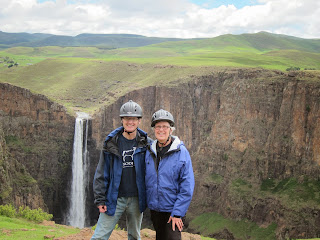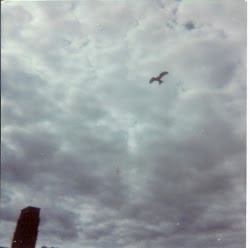THEY RIDE PONIES, DON’T THEY?
Stephanie
and I spent six days visiting Lesotho in December. It is high on the list of
vacation spots for Peace Corps volunteers in southern Africa. Why would people
want to see this small mountain kingdom entirely enclosed within South Africa?
Because it is one of the most beautiful and interesting places on earth. Also, its lowest point of elevation above sea level is the highest of any country in the world, even higher than that of Nepal.
Our friend
from Gaborone traveled with us, and we drove his SUV the 670 km for nine hours
to arrive at our destination. We
traveled across the Northwest and Free State provinces of South Africa,
prosperous farming areas that topographically resemble in some ways the
American Midwest. Along the way we encountered long domed artificial hills that
resembled huge Twinkies: they were created from tailings dug out of a number of
underground gold and diamond mines. We did drive through several larger towns,
and could see the legacy of apartheid: a neat northern European style town
center with shops, government buildings and a large Dutch Reformed Church; on
the outskirts a “settlement”, really a shanty town of many tiny huts. The settlements
now have been upgraded with new concrete block cottages, electricity and street
lighting. The shops and public places in the town seem to be fully integrated:
the challenge for South Africa is the economic divide between racial groups.
Enough politics.
As we
approached the Lesotho border, we could see in the distance the green Maluti
mountain range of eastern Lesotho. Once through the immigration post near
Maseru, the capital, the curves in the road increased along with the elevation
above sea level. We headed toward our first destination: Malealea, a remote
village on the edge of a mountain valley. The roads became steeper up and down
along the edge of ravines cut out of the soft limestone plateau. The pavement
ended 7 km from our destination, where we crossed a mountain pass called the
“Gates of Paradise”, so named because of the spectacular mountain scenery.
The village
of Malealea, dominated by the Lodge of the same name, stood at the end of this
road. The settlement contained two small general dealers (convenience stores),
a school and a clinic. The Lodge featured a conglomeration of chalets spread
along a hillside, some with and without bathrooms, with a large main building
nearby divided into a recreation room, bar and dining room. People come to
Malealea for the outdoor activities. I went mountain biking, led by a merciless
guide who had no sympathy for my current living situation in a flat desert plain. I also went hiking
with a friend to see a steep ravine and falls. We did not hire a guide for
that, thinking that the directions would be adequate. They were not, since they
led us along a stream at the bottom of a ravine blocked by a huge boulder. The
only way forward required us to jump off the boulder ten feet into a pool below
of uncertain depth. We doubled back instead, scrambled up a cliff and then seemed
to have lost our way. But ahead we located a couple, led by a guide. We talked
with them: Dartmouth (Tuck) business students on holiday. I remarked to them how
it seemed they couldn’t take even two weeks away from New Hampshire without
climbing a mountain.
After three
nights at Malealea, we got back in the SUV and traveled for many kilometers
over treacherous dirt roads, on the edge of ravines, up and down over passes,
to a larger village in the middle of Lesotho: Semonkong, elevation 7800 feet.
The village downtown was filled with small horses (ponies) hitched up like
something out of the old American west. The pony owners were busy doing their shopping.
Semonkong Lodge was located on the edge of the village, along a busy horse track
into the mountains beyond. And that is where we stayed for the next three
nights.
Because
Lesotho is so mountainous, most of the settlements cannot be reached by road.
The Lesotho pony has been bred as a compact sure-hoofed method of
transportation. It is clearly the preferred vehicle to get around. Also,
because Lesotho is so mountainous, it gets quite cold, even in summer. So the
Basotho immediately took to the blankets brought by missionaries 150 years ago.
Today, men and women alike wear a colorful wool blanket as outerwear, summer
and winter. There are certain popular patterns and colors. They ride their ponies,
tend their cattle and sheep, and plow their hillside fields while wearing the
blankets. A visitor may forget that he is in Africa: it seems more like a scene
from high up in the Andes.
 |
| Lesotho boy wearing blanket leading me to a waterfall |
 |
| Stephanie on her steed |
At the
lodge, we ran into three Peace Corps volunteers from Mozambique, touring around
after having just completed their service. We also met a Lesotho volunteer
based in Semokong. He told us that he had been trained in pony riding and was
considering getting one to help him in his work. Apparently Peace Corps Lesotho
pays volunteers an extra 300 Rand ($30) per month if they take on a pony. We
urged him to get the pony, if only for the coolness factor upon his return to
the United States, where he could tell listeners about how he spent two years
getting around on horseback in Lesotho.
Peace Corps
volunteers in Lesotho consistently report a very high level of satisfaction
with their placement, despite the mountains, cold weather and primitive
standard of living. They may be on to something.
















